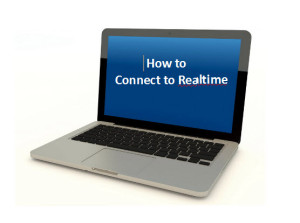 At O’Brien and Bails, we have been providing realtime transcription for quite some time. Our clients find great value in viewing the transcribed spoken word as it is happening. If you’ve never connected to realtime in a deposition before, you may think it is technically difficult. But connecting to realtime is actually simple. Once you know what is involved, you will see that using realtime in your next deposition can be easy and of great value to you and your clients.
At O’Brien and Bails, we have been providing realtime transcription for quite some time. Our clients find great value in viewing the transcribed spoken word as it is happening. If you’ve never connected to realtime in a deposition before, you may think it is technically difficult. But connecting to realtime is actually simple. Once you know what is involved, you will see that using realtime in your next deposition can be easy and of great value to you and your clients.
What is Realtime Transcription?
In a nutshell, realtime transcription is a system whereby the spoken word is recorded by the court reporter and delivered as text on a computer screen within a few seconds of the words being spoken.
Valuable Features of Realtime Transcription
- A rough draft of the written record is available shortly after the proceeding has ended.
- You have the ability to search for keywords in the text.
- Text can be copied and pasted into other documents or emails.
- Transcripts can be shared by the Internet or email.
- During the deposition, reference can be made to previous testimony.
- Drafts can be used to organize the next deposition you may be taking.
- Answers can be reviewed immediately, giving you the opportunity to ask for further clarification if necessary.
How to Connect to Realtime
Connecting your computer to realtime is not difficult. Each court reporting firm may use different software and the process may vary from system to system. It is a good idea to call your court reporting firm before the deposition and ask for a set of instructions for connecting to your court reporter’s specific software.
At O’Brien and Bails, we use two software programs to deliver realtime transcription; Eclipse and CaseViewNet. Some of our reporters use Eclipse, and others use CaseViewNet. These software programs allow us to provide instant realtime text. No matter which program your court reporter is using, you will not need to purchase software or tokens in order to connect to realtime.
Connecting to realtime is easy. Here are the steps involved in connecting with a wireless connection that your court reporter will provide. The first set of instruction is for CaseViewNet. The second set is for court reporters using the Eclipse software.
CaseViewNet Software Realtime Connection
1. Connect to the court reporter’s wireless network.
- Verify that your computer is WiFi enabled. View or connect to the available wireless networks by right-clicking the wireless icon on your Windows taskbar.
- Choose the court reporter’s wireless network from the available networks.
- If required, enter the network key (pass phrase) provided by the reporter.
2. Connect to the court reporter’s realtime system.
- Start CaseViewNet client software.
- Click the Connect button.
- Follow instructions in the Connection Wizard.
3. Provide your log-in credentials and connect to the event.
- Use your name and the name of your organization.
- Provide the event password as provided by the court reporter.
Simple instructions for connecting are provided by CaseViewNet on their website. They also provide instructions for connecting by serial port if wireless is not available.
Eclipse Software Realtime Connection
If your court reporter is using Eclipse software, the following instructions are the ones you will follow to gain a realtime connection on your computer:
1. Go to https://connect.eclipsecat.com.
2. Click the lightening bolt symbol in the lower left-hand corner of your screen.
3. Scroll to find the transcript with which you wish to connect.
4. Enter the password you have been given from your court reporter.
We Make it Easy for You to Connect
Realtime transcription can be a huge benefit to attorneys when preparing cases. We strive to provide realtime in a way that is easy and uncomplicated. If you haven’t connected to realtime transcription in a proceeding before, as you can see, it is a simple process. Your court reporter is available to assist in making the connection so you can receive realtime transcription on your computer and reap the benefits in your next deposition.